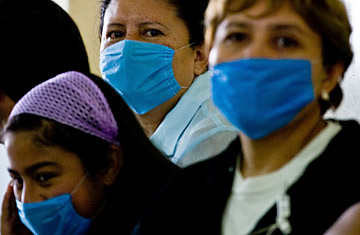
Mexicans protect themselves from the swine flu virus at the Mixcoac health center in Mexico City
(3 of 4)
It hasn't yet. While attention was focused on bird flu in Southeast Asia, H1N1 was evolving in swine in Mexico. In a way, the locus was a stroke of luck — the Mexican government reacted about as well as a country could to a sudden outbreak, and unlike China in its initial response to the SARS outbreak of 2003, it did not hide the presence of the new virus.
But the opening of an unexpected front caught health officials off guard. The lesson here isn't that we should stop worrying about bird flu or Southeast Asia — still the birthplace of most new flu viruses — but that in a globalized, heavily populated world, new viral threats can come from anywhere.
3. Prevention means surveillance.
Before H1N1 became known as H1N1, it was popularly referred to as "swine flu" because scientists determined that it contained mostly pig flu genes. (That's not surprising: pigs can be infected with both avian and human flus and are an ideal genetic mixing bowl.) The term swine flu was confusing, since the virus was circulating in people and was not being transmitted by swine (unlike the avian flu H5N1, which is passed primarily by birds), but it was instructive. It reminded us that new flu viruses begin not in people but in animals and that the first humans to be affected tend to be those who are in close contact with animals.
That means the right kind of virological surveillance might be able to detect potentially dangerous viruses while they're still in animals and even stamp them out before they establish themselves in people. The problem is that animal health gets only a fraction of the funding and talent devoted to human health — the World Organization for Animal Health is a poor cousin to the World Health Organization — even though the two realms are intertwined.
Over the past seven years, H1N1, H5N1 and SARS have all emerged out of animals to infect and kill human beings. That trend must be stemmed. One smart idea is the Global Viral Forecasting Initiative, an NGO that monitors populations that are highly exposed to animals — such as hunters in Africa — in hopes of detecting new viruses as early as possible. "You need earlier and earlier capacity not to overlook the clinically evident cases that can reveal a new outbreak and give you maximum time for preparation," says Institute of Medicine president Dr. Harvey Fineberg, who will lead an independent panel review of the WHO's response to the H1N1 outbreak.
4. Vaccine manufacturing is outmoded, but vaccines are not a panacea.
The good thing about the H1N1 vaccine was that it wasn't technically difficult to create — vaccine makers designed and produced it the same way they do regular, seasonal flu vaccines. The problem was the timing. By the time H1N1 emerged in the spring of 2009, production of the next batch of seasonal flu vaccines was already well under way, so drug companies had to hustle to establish a separate production line to get the new H1N1 vaccine manufactured and available for the upcoming flu season.
At the same time, global vaccine production was in general decline, and the U.S. had very little vaccine-manufacturing capacity left. Worse, there were no official channels of pandemic-level vaccine distribution. Washington promised millions of doses of H1N1 vaccine in time for the start of flu season in October 2009, but distribution was repeatedly delayed while federal, state and local officials struggled to coordinate how best to hand out the doses. If H1N1 had been truly severe, those delays could have cost lives.
But the major hindrance is the way vaccines are currently manufactured — grown in individual doses in batches of chicken eggs. While flu vaccines take months to produce, flu viruses spread around the planet in a matter of days. So unless the U.S. and other wealthy nations upgrade their vaccine-production strategies (experimental cell-based techniques may be able to churn out new vaccines much more quickly) and add more capacity, we're guaranteed to struggle to defend against the next pandemic. Vaccines may represent the best line of defense against a new flu virus, but not if they're too slow to do any good.
Still, it bears noting that vaccines are not the only defense against a flu virus. Other, simpler strategies — like hand washing, sanitation and distancing measures like keeping sick people at home — can quickly stem the spread of a virus.
